________________
40
THE INDIAN ANTIQUARY.
[FEBRUARY, 1906.
We obtain from the above statements the following picture of the distribution of power on the
north frontier of India about the middle of the 1st century B. C. In the P. 76; Distribution of N.-E. and N., i. e, first in Kashmir and latterly in the upper Indus power, 50 B, C.
region at Kabul and Suãt, the Saka race, from the Tarim basin, with an accession of the Turkish eleinent, held sway. North of this, on both sides of the Hindu Kush and on the upper Oxus, the tive Hi-Hou (Jabgu) of the Yuë-chi dwelt. And in the west, finally, in S.Afghanistan as well as in the middle and lower Indus region, there flourished the Indo-Parthian kingdom of the other Saka race who came as fugitives from the old Parthian country. The Chinese designate the first-amod Saka kingdom as Ki-pin, the other as An-si. The peace-loving commercial natives, refined by Greek culture, were soon overpowered and deprived of political unity by the warlike invaders, who however soon began to strive about the booty and supremacy. This may be inferred
from Hou Han shu, ch. 118, fol. 11 vo and 127: “The subjection of the P. 77.
country to the ruling power was never of long duration : of the three countries, India (T-ien-chu), Ki-pin and An-si, the one which was powerful gained the upper hand, the one which was weak lost it. Among the five Hi-Hou provinces which the earlier Annals mention, this did not actually take place. It belonged later to the An.si,aud when the Yue-chi conquered the An-si, they, for the first time, got possession of Kao-fu." Kao-fu corresponds with the kásovpa of Ptolemy and with the modern Kabul, but geographically it must have been the boundary province between An-si and Ki-pin. Marquart with considerable probability identifies it with Gandhara. Cunningharu's identification of it with the wbole of Afghanistan is put out of court by the above citation,
What country Tie-chu ("India") may mean, it is not easy to tell. Immediately after the above translated passage of the Han-Annals, we find that "Tien-chu is another name for Shen-tu (Sindhu); the country lies more than 1000 li S.-E. from the Yuë chi ; its customs resemble those of the Yüe-chi..... the inhabitants are weak against the Yuë-chi. The province of Sindhu
comprises all the country from the Yue-chi and Kao-fu to the S.-W. and
indeed westward as far as the sea, and eastward as far as the country of P'an-k'i. Sindhu has several hundred distinct towns with their governors and several half-scores' of states with their princes, all distinct but having the common name of Sindhu. At that time (?) all was tributary to the Yue-chi. The Yuë-chi killed its prince (or princes) and placed deputies there, who ruled the subjects." These statements shew how vague was the information abunt this country. The coins found in Kabulistan, bearing the image of the Indo-Greek king Hermaios on the one side and the Kushān prince Kozulokadphises on the other, perhaps indicate
that Hermaios was the last Greek king in India and ruled then in the Lassen, von Sallet, and Kabul countries. If this be correct, one might understand by the Rapson.
T'ien-chü of the Han-Annals the Greek kingdom which was divided in the 2nd and 1st century B. C. among the successors of Menandros, the last of whom was Hermaios, The principality of Kushān, as we say, came out as final victor in the struggles for supremacy in
N. India. The two conquerors, father and son, are called by the Chinese Kaniska identified with K'iu-tsiu-k'io and Yen-kao-chên. Both these rulers must have made K'iu-taiu-k'io. Not satis factory.
a great name ior themselves. It is, accordingly, no far-fetched theory to
see in one of them, preferably the first, the most eminent of the Kushan princes, Kanişka. Many scholars have concluded that this identification is correct. Marquart,
who at first was of this opinion, has returned to Cunningham's
older identification which transliterates K'i-tsiu-kio by Kozulokadphises mentioned above. This is rendered the more likely theory by the transliteration of the name of the Bon Yen-khao-chên, which becomes Oēmokadphiaes. Where then must we seek the mighty Kanişka ? The succession of princes (with one exception, as we shall see later) of Kushän kings
is: Kozulokad phises, Oēmokadphises, Kaniska, Huviska, Väsudeva. Knabas princes.
V. Smith dates Kaniska at 125 A. D. The dates assigned by others vary according to their dates for the founding of the Yuë-chi.
P. 78.
P. 79.




